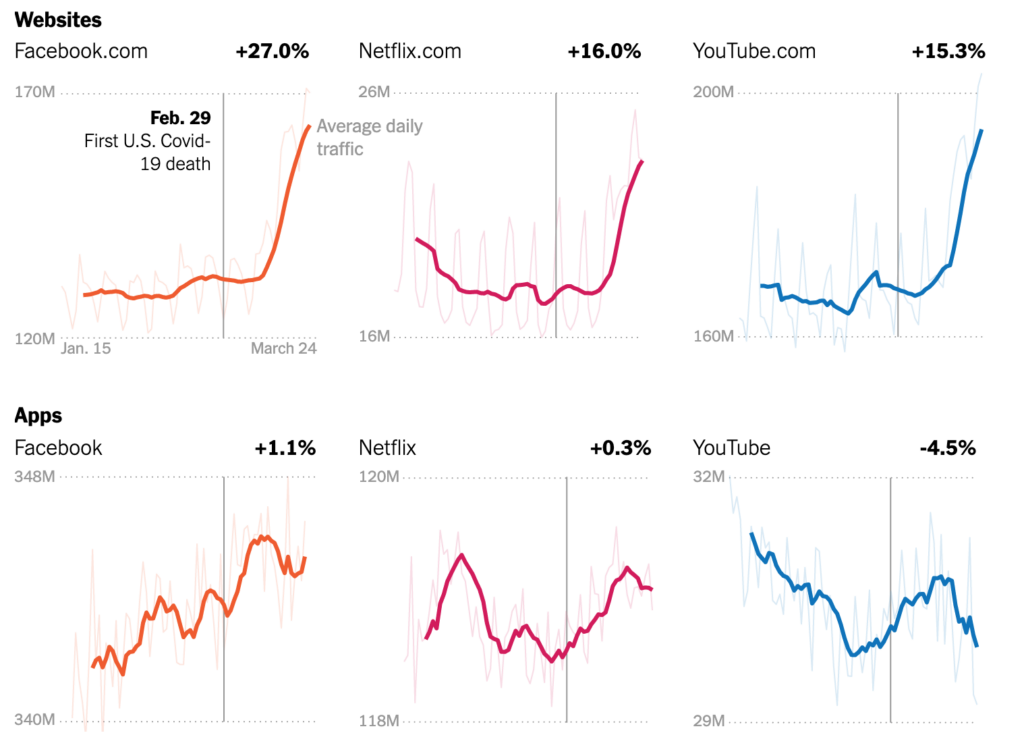In the Age of Covid, What Comes Next in Digital?
By Michael Finn
The COVID-19 pandemic has had a massive impact on human behavior across the globe. There has been no shortage of news reports telling us how social distancing and lockdowns have changed the way we work, learn, eat, shop, and entertain ourselves. Digital channels have become an indelible part of our lives and how we behave on them is more important than ever. While these changes have been developing for years, there’s no denying the COVID-19 crisis delivered a huge boost to digital activity, and many of the changes are here to stay.

Source: The New York Times
So which corresponding changes do companies need to make to thrive in this new world? They fall in two broad categories.
First, data-driven companies must now find effective ways to harness this digital behavioral data to improve all aspects of their business – from revenue forecasting, to inventory management, and supply chain. Companies have invested huge amounts of resources in making data-driven decisions. They’ve developed data strategies, built data governance organizations, and staffed analytics and insights teams – but digital behavioral data from websites, apps, and devices is conspicuously absent. Unless your company is a digital titan, like Amazon, Netflix, Uber, or Spotify, your digital behavioral data might be dumped in a data lake somewhere, but it isn’t being used to drive important decisions across the business.
Second, consumer-facing brands must increase their commitment to digital experiences. Their websites, apps, and devices are now first-class citizens of the business – no longer afterthoughts. Many companies have been pursuing these kinds of activities in the context of a large-scale digital transformation project. After spending millions of dollars over several years, however, these “cathedral-building” projects haven’t delivered value, and they are being cut aggressively as firms lower their expenses. Paradoxically, the driving need for these experiences is more important than ever, so digital professionals need to identify more tactical projects that can be deployed quickly and provide clear financial benefits.
In our conversations with our clients, their most immediate priority is to cut costs. A few of the specific ideas we’ve discussed for short-term initiatives are:
- Limit audiences for advertising campaigns to those who are most likely to purchase and eliminate the rest
- Forecast likely purchasing behavior by location for better sales forecasting and inventory management
- Automate digital data flows that are currently being processed manually
Many of us are understandably consumed by the crisis and can’t find the time to think beyond today. Others, however, aren’t directly involved in the Corona response – freeing them to prepare their organizations for a future where this permanent acceleration in the shift to digital will affect their work, their teams, their families, and their lives.
The name of the game is Think Big, Start Small. You don’t need a cathedral – you just need to get started with these three steps:
- Get a handle on your first-party behavioral data; get it out of your data lake and into a place it can be more useful and productive
- Refocus your investments away from cathedral-building projects and toward technologies which leverage digital behavior to deliver near-term financial results
- Use Machine Learning and Artificial Intelligence to cut your labor cost to minimum
